
The journey is …as important as the destination. Learning is a process, not a product. It takes place at the child’s pace, not when the teacher says it, not when the parent wants it, but when the child is capable, relaxed and ready. Create a positive learning environment, enjoy each session for its own sake.
Harmony with… the water. Smooth swimming, not thrashing, takes practice, patience and a great deal of time. At each level, we are setting a foundation. Each age group has new and more complex skills compatible with the developmental abilities of that group. It is best to introduce skills only when they can be acquired with ease and confidence. Every child gets there in the end, if you put the time in at the beginning.
Together…parents, children and teachers are part of a much larger picture. It’s about developing a parenting style in relation to your child’s learning style; learning to encourage and support rather than demand and demean. Remember to praise, not push. Never compare your child with peers or siblings. Just as walking, potty training and reading all come at different age and rates of acquisition so too does swimming come. There is no deadline. Invariably, the slower we go, the faster they learn and the better the retention and technique of the learner. We must remember that while we teach the children to respect the water, we must never lose our respect for the children in the learning process.
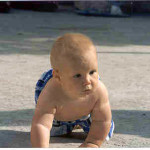
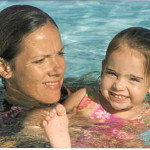
Comfort is the key…
Before we explore what infants and toddlers can learn under the surface, it is important to have your child comfortable above the surface. Your baby needs to be relaxed in the swimming pool with you and feel at ease in the social setting of a group class. Once your child is adjusted to this new aquatic classroom, you will want to slowly and gradually over days and weeks adjust them to water dripped over their forehead. Eventually, you can smoothly pour a small stream of water down their forehead across their face, on the count 1-2-3-pour (just several times a session). Keep it fun and playful, using toys, songs, a washcloth, etc. This will prepare your baby for the learned breath holding “cue” during their initial submersions. The ideal situation would be to initiate this facial water adjustment in the bath tub in the months prior to class (no shampoo and soap). By the time your child is ready to begin class they will have accomplished their first major hurdle in learning to swim like a “Diaper Dolphin”, being adjusted to the water.
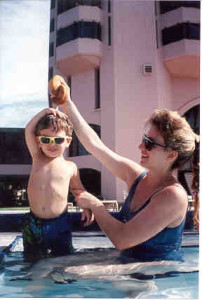
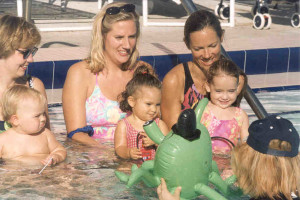
Brief Overview of Swimming Skills
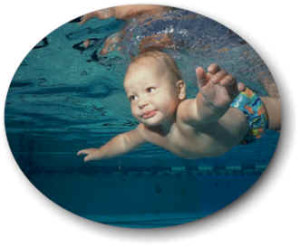 The purpose of the following skill profile is to provide you with a broad idea of the potential that exists at various ages. This chart is intended to reflect the skills and abilities of children with long term swimming experience who swim with ease and confidence. Many factors weigh into a child’s progress, such as comfort, experience, confidence, frequency of practice, motivation, innate abilities and the attitude of the parents. Beginners entering a program would need to start with water adjustment and gradually acquire new skills in a sequential learning progression, regardless of age. For example, a 3 year old new to swimming would start with the first level of skills.
The purpose of the following skill profile is to provide you with a broad idea of the potential that exists at various ages. This chart is intended to reflect the skills and abilities of children with long term swimming experience who swim with ease and confidence. Many factors weigh into a child’s progress, such as comfort, experience, confidence, frequency of practice, motivation, innate abilities and the attitude of the parents. Beginners entering a program would need to start with water adjustment and gradually acquire new skills in a sequential learning progression, regardless of age. For example, a 3 year old new to swimming would start with the first level of skills.
Highlighted below is a sampling of skills that can be learned by experienced swimmers:
Some relaxed infants as young as 6 months -10 months old with proper prerequisites and training can learn to hold their breath on cue when dipped underwater. For those who continue to practice, by 12 months of age some will be able to swim 5 seconds between two adults, swim to, reach for and grab onto the side of the pool, as well as, perform a sitting jump off the side. They will also begin to participate in songs, games and express their joy with smiles. For those families whose circumstances do not allow adequate practice time to reach the 5 second swim, familiarizing your child with the water at young ages sets a positive foundation for lessons when they are older.
Some toddlers as young as 19 months-24 months old once they have accomplished the above skills with proper prerequisites and training can begin to learn to jump off the side of the pool, turn around and swim back to the side. For those who continue to practice, by the age of 25 months old, a great spurt in endurance and kicking ability can occur.
Some experienced toddlers by the age of 28 months-36 months can begin to learn to recover up for a breath. However, teaching this skill too young can create vertical “water walkers.” We wait until our swimmers begin to self-initiate this skill and have developed a strong flutter kick before we introduce it.
Some seasoned 36 month-4 year olds will begin to back float. As the 4th birthday approaches, more children will accept the back float. Our experienced 3 1/2 year olds will flip from front to back and vice versa. The vast majority of infants and toddlers are not comfortable on their backs until at least 3 years old. Children love swimming under the surface at this age.
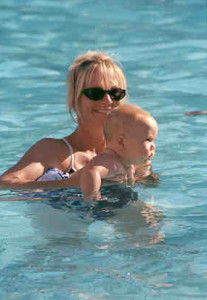
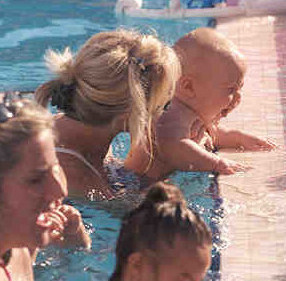
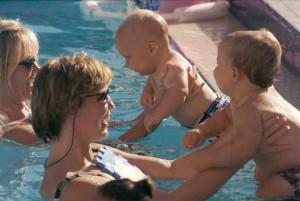
A few year-round students will be able to accomplish the above skills with ease and confidence at earlier ages. However, the acquisition of such skills through forceful means, by an adult over a child, is inappropriate and distressful to the child. We will only introduce experienced and receptive babies to back float exercises. This process is presented through fun games and activities. It must be noted that making back float an imposed priority to unwilling infants and toddlers can have a devastating effect on the well-being of the child. The same holds true for forcing children underwater on their front before they are ready.
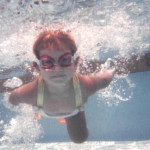 Our goal is to address the whole child, setting a strong foundation not only as a comfortable, relaxed swimmer but foremost creating an opportunity to help foster a well adjusted, happy human being.
Our goal is to address the whole child, setting a strong foundation not only as a comfortable, relaxed swimmer but foremost creating an opportunity to help foster a well adjusted, happy human being.
[callout font_size=”13px” style=”bluegrey”]
“A smiling teacher sensitive to you child’s feelings during the class is desirable. Teachers are forever smiling and expressing joy in working with children. Realize that swimming skill and safety behavior around water grows along with your child. Plan to enroll them in a program yearly during early childhood. While there is variance as to the age a child becomes ‘water competent’ the good news is that every child can ‘get it’ – in time with your support. Swimming and water safety behavior are lifesaving and life maintaining skills (recreation, health and fitness) that are rightfully learned at an early age.”
– Steve Graves, President World Aquatic Baby Congress .[/callout]